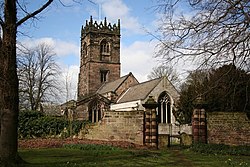Aston, Yorkshire
| Aston | |
| Yorkshire West Riding | |
|---|---|
 All Saints' church | |
| Location | |
| Grid reference: | SK460848 |
| Location: | 53°21’29"N, 1°18’36"W |
| Data | |
| Post town: | Sheffield |
| Postcode: | S26 |
| Dialling code: | 0114 |
| Local Government | |
| Council: | Rotherham |
| Parliamentary constituency: |
Rother Valley |
Aston is a residential village in the West Riding of Yorkshire; one grown large, just beyond the south-eastern edge of Sheffield. Aston is about two miles from Rother Valley Country Park. The M1 motorway slices through the landscape at the eastern edge of the village.
Aston was traditionally a farming village and some old farm buildings still line the main road. In the early 20th century the population increased because of the opening of coal mines in the area.
Name
Unlike other places of the same name, Aston does not mean "eastern farm or village," but is uncertain, except that the name originates in Old English. The first element of the name is uncertain, while '-ton' is, as throughout the land, the Old English for 'estate', 'village' or 'farmstead'. The name is recorded as Essetone in the Domesday Book. This suggests the Old English æsc; 'ash tree', though this is not certain.
Parish church
All Saints Church is the oldest surviving structure in the village. It is a Grade I listed building, built on the site of earlier church listed in the Domesday Book. Parts of it date to 12th, 14th and 15th centuries though with restoration works including rebuilding of the chancel in the 19th century
Monuments in the church include two wall plaques to the poet William Mason a former rector of the church.[1][2]
The old rectory building on Church Lane was also worked on by John Carr, it is named High Trees and is Grade II listed[3]
About the village
At the eastern end of the village is Grade II* listed Aston Hall, which was a large country house, afterwards a hospital, and at one time known as Aughton Court before becoming a hotel and restaurant.[4] It gives its name to Aston Hall Cricket Club, which plays home games close to the Hall. A nearby street named "The Chase" suggests that the surrounding housing estate now occupies land that formed the traditional hunting grounds attached to the hall.
The village has a number of 18th and early 19th century buildings along the main road (Worksop Road) including The Grange and South Farm.[5][6] To the north of these on Aughton Lane is the William Layne Reading Room, a building that was formally Aston Old School, founded in 1738, next to which stands a war memorial erected in 2011.[7]
Outside links
| ("Wikimedia Commons" has material about Aston, Yorkshire) |
- Aston, Yorkshire in the Domesday Book
References
- ↑ "History". All Saints Aston-cum-Aughton. http://allsaintsaston.com/?page_id=29. Retrieved 18 October 2016.
- ↑ National Heritage List 1151917: Church Of All Saints (Grade I listing)
- ↑ National Heritage List 1151919: High Trees (Grade II listing)
- ↑ National Heritage List 1314660: Aughton Court (Grade II* listing)
- ↑ National Heritage List 1314658: The Grange (Grade II listing)
- ↑ National Heritage List 1151886: South Farm House (Grade II listing)
- ↑ National Heritage List 1314672: The Parish Council Reading Room (Grade II listing)